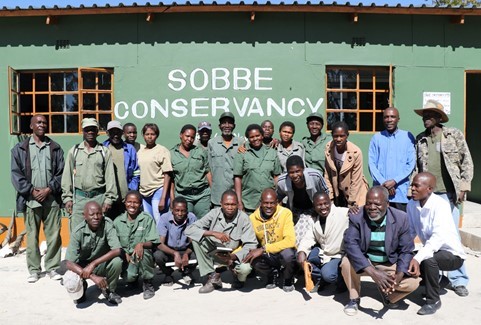
Innovative Conservation In The Sobbe Conservancy In Namibia
In Namibia and in most parts of Southern Africa, wildlife does not only serve an ecological purpose, but it also offers a crucial supplementary nutritional and economic gain to rural communities. Through initiatives, such as Ecotourism and Wildlife Credits, payments for ecosystem services have not only generated sustainable income but also give incentives to environmental custodians for protecting habitat and crucial wildlife corridors.
In August 2018, Amarula/ Distell Namibia joined forces with Wildlife Credits and the Sobbe Conservancy to foster an innovative conservation initiative that rewards communities who are actively protecting and conserving wildlife and its habitat. This is cutting edge conservation, where funding is paid directly to communities for measurable conservation results. The Sobbe Conservancy have been proactively protecting a wildlife corridor that is critical to elephant movements between Botswana, Namibia, Angola and Zambia.
The company donated a one-time payment of N$130,000 to the Sobbe Conservancy for their ecosystem service of protecting a critical wildlife corridor. The payment was managed by and under the auspices of Wildlife Credits, an innovative financing mechanism where 100% of the contribution to Wildlife Credits goes to the stewards on the ground for verifiable conservation results. Wildlife Credits creates an avenue for funding conservation performance on the ground and ensuring that the impact of every dollar contributed rewards conservation results.
Since this partnership was announced in 2018, the Sobbe Conservancy has used its support from Amarula to make significant progress in its ongoing, pro-active protection of the wildlife corridor, which is essential to the free migration of elephants throughout the region.
“For many decades, people lived with wildlife, but the numbers were declining. Now, school learners say thank you that they can also know these animals.” Keleso Nombano – Traditional Authority, Sobbe Conservancy, Zambezi Region, Namibia.
With elephant populations declining across most of Africa, the importance of the elephants that use this wildlife corridor cannot be underestimated. They are part of the 220,000 elephants in the Kavango-Zambezi Transfrontier Park (KAZA), the largest population of elephant left on the planet.
Innovation is key to the future of community-backed conservation, as realized in the partnership between Amarula, Sobbe Conservancy and Wildlife Credits. While the scale of this partnership was one corridor in one conservancy, the protection of this corridor has global impact in protecting habitat, fighting climate change and ensuring wildlife connectivity, while rewarding local communities who pay the price for living with wildlife.
Wildlife Credits under the auspices of the Community Conservation Fund of Namibia, who now houses Wildlife Credits is seeking to build up a Corridor Fund that can finance annual payments for communities are able to independently verify the protection and wildlife use of the corridors. The initial target of CCFN is to secure N$ 50,000 per year per corridor.
Based on the successful piloting of the Wildlife Credit payments, there are several options to build up these efforts both in the Sobbe Conservancy and the Zambezi Region. the Amarula, Wildlife Credits, and Sobbe partnership has sparked interest in seven conservancies that are keen to be involved. They have each selected priority corridors to manage for the benefit of both their members and their wildlife.
This is the community’s choice, one that does not come lightly considering what hardships elephants can bring to rural farming communities, but one that will help to ensure the protection of elephants now and for generations to come.
We see no reason why such a pilot cannot be replicated with other species and communities to aid and reward all conservation efforts in rural Namibia. The Community Conservation Fund of Namibia has been mandated by the Namibian CBNRM family to bring together the various stakeholders and facilitate the up-scaling of Wildlife credits in Namibia. Despite the challenges expected, we look forward to this journey with anticipation and enthusiasm. This is the right time for such an initiative to grow as the advent of COVID-19 has further cemented the need for alternative forms of income other than the traditional reliance on tourism to finance and reward conservation efforts and outcomes. We invite you to walk this journey with us.
– Wildlife Credits Namibia – Rewarding communities for Conservation Outcomes –
